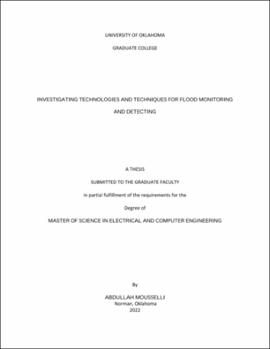| dc.contributor.advisor | Refai, Hazem | |
| dc.contributor.author | Mousselli, Abdullah | |
| dc.date.accessioned | 2022-08-08T16:13:01Z | |
| dc.date.available | 2022-08-08T16:13:01Z | |
| dc.date.issued | 2022-08-04 | |
| dc.identifier.uri | https://hdl.handle.net/11244/336459 | |
| dc.description.abstract | The need for a flood alerting and forecasting system is becoming ever more critical, especially given the effects of increasing severe weather over the last ten years. Flash floods, particularly, are deadly because of the short time period in which they develop, as well as the difficulty in predicting their occurrence. Consequently, floods have become recognized as the most fatal natural disaster in the United States. Recent developments in artificial intelligence (AI) and machine Learning (ML) algorithms are promising for overcoming related issues by providing data driven solutions for more reliable and efficient forecasting. The study reported in this thesis first explored market-available, industrial-based flood monitoring and alerting systems developed and deployed by several private companies and federal agencies. Weather conditions that accompany flash flood events were then analyzed as first steps in building an ML flood forecasting model. Weather attributes were analyzed both statistically and visually to uncover their importance for modeling. Subsequently, common ML classification techniques were compared with a variety of neural network architectures to determine the best model for forecasting flooding. Modeling results showed that a one-hour forecast XGBoost ensemble model outperformed others, with an 85% accuracy for forecasting a flood event and a 92% AUC score. This thesis introduces a novel approach for evaluating non-contact flood detection technologies. An open-channel testbed was designed and constructed, and several non-contact water level and velocity technologies were evaluated under various conditions. Results showed that market available radar technology delivered the most accurate readings with an MAE score of approximately 2 cm and MAE of 0.1 m/s. | en_US |
| dc.language | en | en_US |
| dc.subject | Machine Learning | en_US |
| dc.subject | IOT | en_US |
| dc.subject | Controlled Environment Testing | en_US |
| dc.title | Investigating technologies and techniques for flood monitoring and detecting | en_US |
| dc.contributor.committeeMember | Tang, Choon Yik | |
| dc.contributor.committeeMember | Cheng, Samuel | |
| dc.date.manuscript | 2022-07-19 | |
| dc.thesis.degree | Master of Science | en_US |
| ou.group | Gallogly College of Engineering::School of Electrical and Computer Engineering | en_US |
